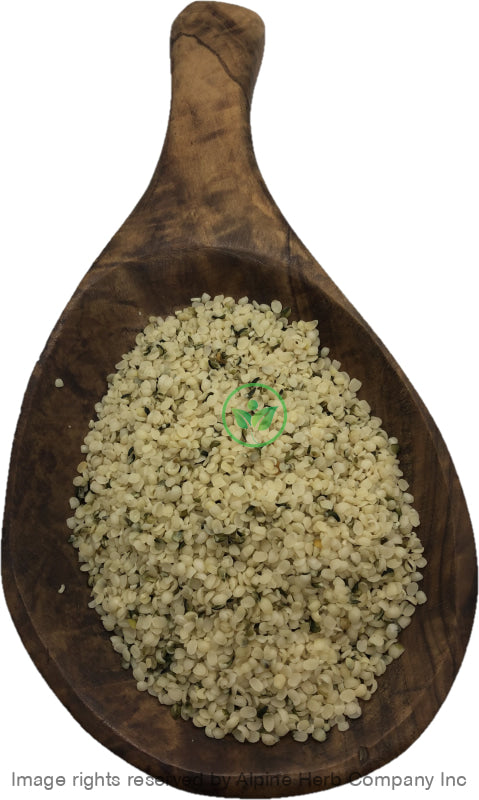Hemp Heart Alpine Herb Company Inc.
$ 6,49 $ 3,89
Botanical Name: Cannabis sativa
Common Name:
- English: Hemp Nut
- Also, known as: Hemp Heart, Shelled hemp seeds
Origin: Canada
Harvested: Cultivated
Parts Used: Seed
General Information:
Cannabis sativa is an annual herbaceous plant in the Cannabis genus. It is a member of a small, but a diverse family of flowering plants of the Cannabaceae family. It has been cultivated throughout recorded history, used as a source of industrial fiber, seed oil, food, recreation, religious and spiritual moods, and medicine. Each part of the plant is harvested differently, depending on the purpose of its use. The flowers of Cannabis sativa are unisexual and plants are most often either male or female. It is a short-day flowering plant, with male (staminate) plants usually taller and less robust than female (pistillate) plants. The flowers of the female plant are arranged in racemes and can produce hundreds of seeds. Male plants shed their pollen and die several weeks prior to seed ripening on the female plants.
Hemp seeds are exceptionally nutritious and rich in healthy fats, protein, and various minerals. Hemp seeds contain over 35% fat. They are exceptionally rich in two essential fatty acids, linoleic acid, omega-6 and alpha-linolenic acid, omega-3 and the rare omega-6 Gamma Linolenic Acid-GLA. GLA, which has been linked with several health benefits. They are also a great protein source and contain high amounts of vitamin E, phosphorus, potassium, sodium, magnesium, sulfur, calcium, iron, and zinc. Hemp seeds are a great protein source, as more than 30% of their total calories are from high-quality protein. That is considerably more than similar foods like chia seeds and flaxseeds, which provide about 18-20%. Hemp seeds are also a great source of vitamin E and minerals such as phosphorus, potassium, sodium, magnesium, sulfur, calcium, iron and zinc. Hemp seeds can be consumed raw, cooked or roasted. Hemp seed oil is also very healthy and has been used as a food-medicine in China for at least 3,500 years.
Today, it is widely accepted that marijuana has two different species: Cannabis indica and Cannabis sativa. Both of these words come from Latin. The title indica originally came from the fact that the plant came from India. Indica is Classical Greek and Latin for India. Sativa, on the other hand, is one of three (Sativum and Sativus) Latin adjective that means “cultivated”. However, hemp seeds contain only trace amounts of THC, the compound that causes the drug-like effects of marijuana. The differences between indica and Sativa remain a subject of much debate, especially among scientists who study the plant. However, most agree that indica and Sativa plants are distinct in a number of ways. The most accepted way of distinguishing indica versus sativa is by appearance, or what scientists refer to as morphology. While both of these plants have green leaves, for the most part, Indica is a bit darker than sativa. Indica plants are short around 2-4 feet, densely branched and have wider leaves.
Indica plants make up for their height with their dense clusters and thick and heavy buds. These plants are likely to be quite aromatic. Its branches are dense, and it produces more buds than sativa plants. Indica is often grown in mountains and rougher weather conditions. Because of its high density, indica usually has a higher THC ratio compare to sativa.
On the other hand, Sativa, tends to be light green with thinner leaves. Sativa plants are typically tall, around 20 feet though most are only about 6 feet on average and thin with branches far apart from each other.Nearly all hemp grown for industrial purposes is Cannabis Sativa. As the tallest variety, it produces the longest fibers and therefore has the widest range of industrial uses.
How to use:
As a food supplement.
Precautions:
You should consult with a qualified healthcare practitioner before using any herbal products, particularly if you are pregnant, nursing, or on any medications.
All information on this website is for educational purposes ONLY.
This information has not been evaluated by Health Canada.
This information is not intended to diagnose, treat, cure, or prevent any disease.
| Unit Size | 100g, 200g, 400g, 1kg |
|---|
Prompt shipping and expert packing
Thanks to our longstanding association with UPS FedEx DHL as well as other leading global carriers, we can offer a variety shipping options. Our warehouse staff is highly trained and will be able to pack your goods in accordance with our precise and exact specifications. Your items will go through an exhaustive examination before they will be securely packaged before being delivered. We ship to hundreds of thousands of customers daily in different countries. This is a sign of our determination to become the largest online retailer worldwide. Warehouses and distribution centers are located throughout Europe as well as in the USA.
Note that orders containing multiple items are processed according to the particular item.
We will thoroughly inspect all items ordered before shipping. Most orders are shipped within 48 hours. The delivery time will be between 3 and 7 working days.
Returns
The stock market is always changing. It's not entirely managed by us since we're involved with several entities, including the factory and the storage. Therefore, the actual inventory could fluctuate at any moment. Please be aware that it is possible that your order could be out of stock after you've placed your order.
Our policy lasts for 30 days. If it's been more than 30 days since the date you purchased your item We're sorry to say that we can't offer you a full exchange or refund.
You can only return a product if it is unused and still in the same state as when you received it. The item should be in the original packaging.


































